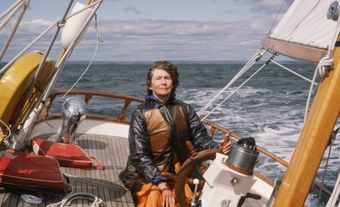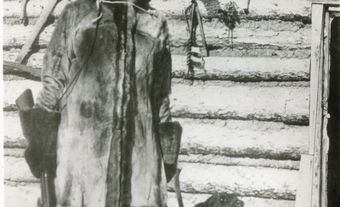While the majority of geographic features in Canada are named after men, there are examples from coast to coast of places named for women. These place names reflect the story of Canada and were chosen for a variety of reasons. Some celebrate trailblazers and their accomplishments. Others are named for locals, or the friends and family of the person naming them. They can honour individuals lost during wars and women who made their mark on history. Here are 10 mountains in Canada that bear the names of women.
Mount Martha Black, Yukon (2,512 m)
Chicago-born Martha Black arrived in Yukon as part of the Klondike Gold Rush stampede. While she never found success in gold mining, her family settled in Dawson City and established a sawmill. A botanist, she was elected as a fellow of the Royal Geographical Society for her work studying the flora of the Yukon. In 1935, she became the second woman in Canada elected to the House of Commons, representing Yukon in the seat previously held by her husband.
Mount Howard-Stowe, British Columbia (2,315 m)
Mount Howard-Stowe is part of the Liberated Group, a range of 11 mountains named after significant women in Canadian history for International Women's Year in 1975. Emily Howard Jennings Stowe broke many barriers in her lifetime: she was the first woman to be principal of a public school in Ontario, the first woman to open a medical practice in Canada, and one of the first two women to be admitted to the University of Toronto’s medical school. She was also a leading figure in the Canadian women’s suffrage movement, and in 1883 she helped establish the precursor to Women’s College Hospital in Toronto, Canada’s first medical school for women.
Mount Wake, British Columbia (2,320 m)
Mount Wake is named for Gladys Maude Mary Wake, a Nursing Sister who died in service during the First World War. Wake volunteered with the Canadian Army Medical Corps in 1916 and served in the United Kingdom and Greece before her final posting at the Canadian General Hospital in Étaples, France. She died from the wounds inflicted during an air raid on the hospital in May 1918. Wake and two fellow nurses at the hospital, Margaret Lowe and Katherine Maud Mary, were the first Canadian nurses killed in action.
Mount Alberta, Alberta (3,618 m)
Princess Louise Caroline Alberta, the fourth daughter of Queen Victoria and Prince Albert, is the namesake of several places in Canada: the province of Alberta, Lake Louise, and Mount Alberta, in the Rocky Mountains. As the wife of John Campbell, Marquess of Lorne, the fourth Governor General of Canada, Princess Louise was the vice regal consort of Canada from 1878 to 1883. An artist herself, she and her husband founded the Royal Canadian Academy of Arts. On a royal tour in 1882 she became the first member of the royal family to visit British Columbia.
Mount Mary Vaux, Alberta (3,208 m)
Mary Schӓffer Warren named Mount Mary Vaux for her friend Mary Vaux Walcott. The mountain overlooks Maligne Lake in Jasper National Park. Warren surveyed the lake and its surrounding peaks in 1911, while Walcott, an American, visited the Canadian Rockies annually with her family. On these visits, Vaux Walcott and her brothers conducted some of the earliest glacial research in Canada. In addition, she spent over 25 years studying, photographing and painting the flora of the Rockies. The culmination of her work was a five-volume illustrated book series, North American Wild Flowers, published between 1925 and 1929. The Smithsonian Institute, that published the series, meticulously reproduced over 400 of her watercolours at a cost of $750,000 USD (over $12.5 million USD today).
Mount Tuzo, British Columbia/Alberta (3,246 m)
Peak Seven of Banff National Park’s Ten Peaks was renamed for its first recorded climber, Henrietta Tuzo. Tuzo is considered the first Canadian-born woman mountaineer and was a founding member of the Alpine Club of Canada. While she had few opportunities for climbing after moving to Ottawa in 1907, Tuzo remained involved in the community through her work with the Canadian National Parks Association. She was involved with several organizations in Ottawa, including as president of the National Council of Women of Canada.
Mont Gabrielle-Roy, Quebec (715 m)
Mont Gabrielle-Roy was named in honour of the renowned Francophone author on the first anniversary of her death. Gabrielle Roy began her career as a teacher in Manitoba before moving to Europe to study dramatic arts, then to Montreal, and later to Quebec City. She worked as a freelance journalist before publishing her debut novel, Bonheur d'occasion (1945), which achieved immediate success and birthed the urban novel genre in Canada. She wrote several more novels and received numerous awards and honours for her literary achievements.
Mount Marie, New Brunswick (661 m)
This mountain in the Appalachians is named after Acadian heroine Françoise-Marie de Saint-Étienne de La Tour, who is remembered for her bravery during civil war in Acadia. She supported her husband, Charles de Saint-Étienne de La Tour, in his fight to claim governorship of the region. While Charles was away in 1645, Françoise-Marie took command when Fort La Tour was attacked by Charles’ rival Charles de Menou d’Aulnay. With just 45 men, she held off d’Aulnay’s 200-man force for three days before surrendering. D’Aulnay reneged on the conditions of surrender and executed the members of the fort in front of Françoise-Marie, who died three weeks later.
Mount Manny, New Brunswick (626 m)
Mount Manny was named in honour of New Brunswick historian and folklorist Louise Manny. In 1947, Manny was commissioned by Max Aitken (Lord Beaverbrook) to record the folk songs of New Brunswick. She recorded three collections of songs, which she played on the weekly radio programme she hosted. Manny was the founder and first director of the Miramichi Folksong Festival, the longest running festival of its kind in Canada. She also published books on New Brunswick's folk songs and shipbuilding history and established a library in Newcastle, New Brunswick.

Mount Caubvick, Newfoundland and Labrador (1,652 m)
The tallest mountain east of the Rockies, Labrador’s Mount Caubvick is named for Caubvick, an 18th century Inuk woman. She was part of a family of five Inuit to accompany George Cartwright, an English entrepreneur, to England in 1772. While it was not unheard of for Europeans to bring Indigenous peoples with them back to Europe—sometimes willing, other times not—Caubvick and her family attracted a great deal of attention. Cartwright eventually had to limit visitors eager to see his Inuit guests to twice a week. Tragically, Caubvick and her family caught smallpox just before they were due to return to Labrador. Caubvick was the only one of the five to survive and return home.

 Share on Facebook
Share on Facebook Share on X
Share on X Share by Email
Share by Email Share on Google Classroom
Share on Google Classroom



